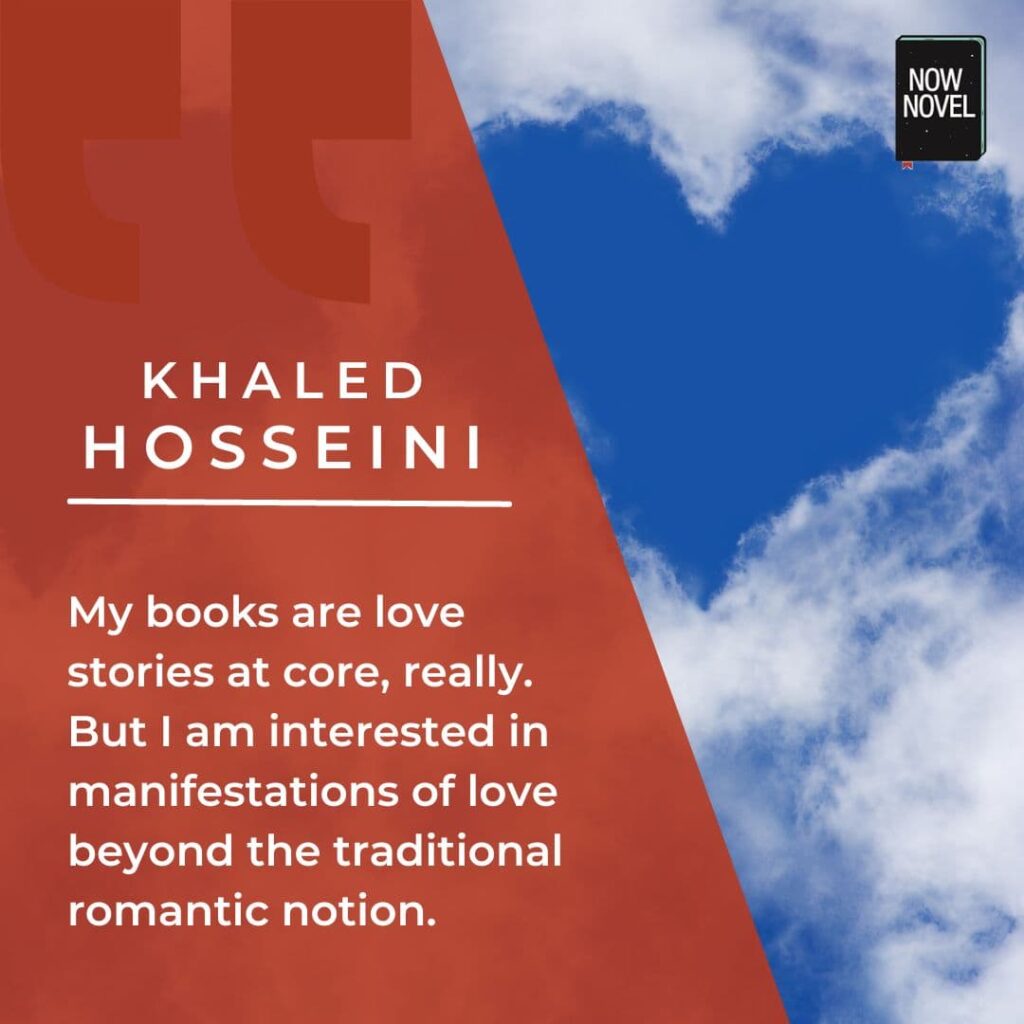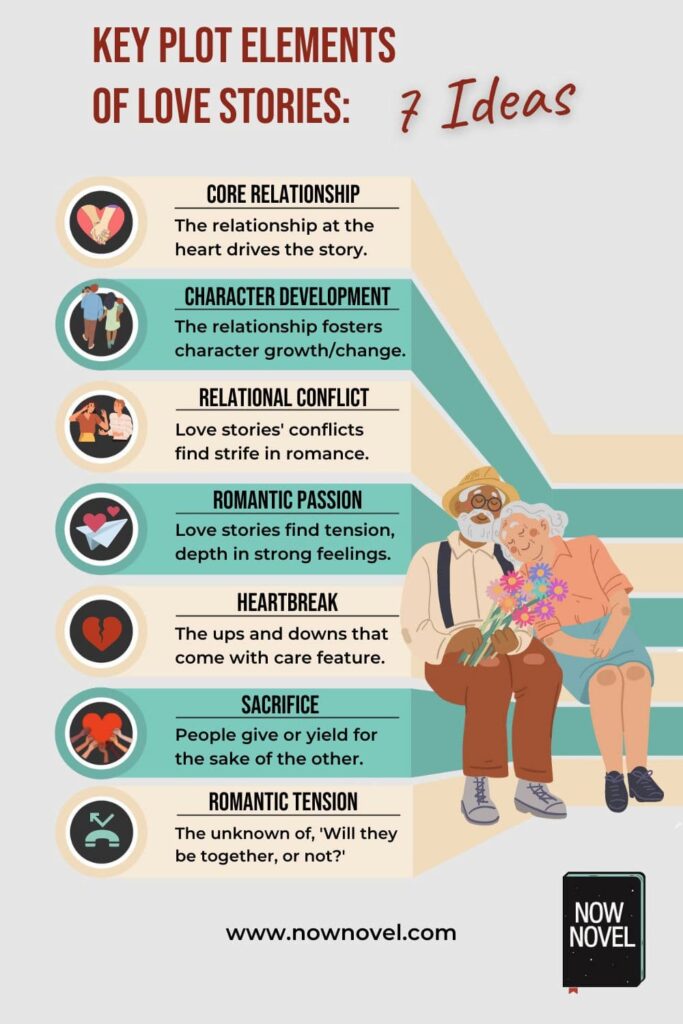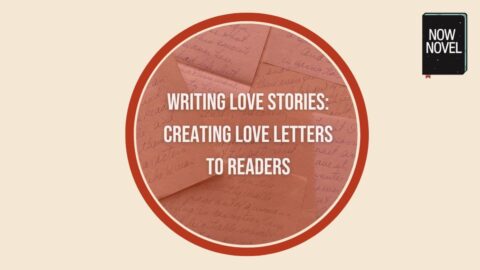Writing love stories is popular for many reasons. Genre romance is one of the biggest categories by sales in the publishing industry, year after year. There is a common misconception writing romantic stories is easy. Yet developing characters who readers are ready to ship, stan, and swoon over is hard. Keep reading for ideas on writing romantic stories, the difference between love stories and genre romance, and more:
Writing love stories vs genre romance: What’s the difference?
Does the term ‘love story’ mean the same as ‘romance’? Not necessarily.
Genre romance is a broad category with many subcategories and has several defining features:
- Genre romance stories tend to follow common genre formulae, such as plot structure and other conventions. For example, in a feel-good romance, lead characters always end up together for a ‘happily ever after’ or ‘happy for now’
- Genre romance does not feature a relationship only as a subplot or secondary/minor focus. This is unlike, for example, a literary novel that contains a major (or minor) romantic arc. The romance is central to the story
‘Love stories’ is a broader term because these stories include books that feature:
- Non-formulaic, experimental or genre-bending elements. For example the mix of sci-fi and drama in the Michel Gondry film, Eternal Sunshine of the Spotless Mind
- Non-traditional relationships with ambiguous relationship development or story endings. For example, the love triangle in Michael Cunningham’s A Home at the End of the World (1990)
- Books that have sad, shocking or unconventional romantic endings
- Romantic plot lines which aren’t necessarily the sole focus of the book (but are central enough for the book to be classified a love story)

What makes a love story? Hallmarks of romantic tales
Writing romantic stories goes back to the 12th Century (in tales of chivalry with their honor-defending knights and ‘damsels in distress’) and earlier. In ancient myths (such as the Greek myth of Orpheus and Eurydice), inseparable lovers bargained with Gods to be together.
Many love stories, like the movement of Romanticism, favor expression of strong feeling and individual power and action over calm logic or group consensus. The inner world of the individual over the rule-bound world of societal mores.
Tweet This
Key plot elements of love stories
The core elements of love stories include:
- A relationship that is developed over the story’s course. There may be other passing conflicts or plot intrigues, but the relationship is more than incidental.
- Character development: Writing love stories requires showing how the central relationship in the story challenges characters. How does the relationship test them, drive their growth?
- Relationship-derived conflict: In many love stories, the relationship itself is the source of conflict. For example, the love across forbidden lines drives the leads’ internal conflict in Shakespeare’s Romeo and Juliet.
- Romantic passion: Love stories may explore asexual or aromantic partners who connect in other meaningful ways. Yet more often, passion – strong feeling, physical and/or emotional attraction, and desire – is the driving force of the story.
- Heartbreak or ups and downs: Romantic stories are seldom about ‘happy people in happy land’. Characters have flaws, fumble and stumble. Connections are missed (or nearly missed).
- Sacrifice: Often love stories explore the enormous (and even foolish) sacrifices people make for love. For example, The Little Mermaid giving up her aquatic home, tail and (depending on the version) voice. Ed’s note: Alice Munro speaks here about the profound impact this story had on her as a young, budding writer.
- Romantic tension: There is often the unknown (and resulting suspense) of whether would-be lovers will end up together. Many sitcoms revolve around enemies to lovers tropes, for example, where coworkers or roommates discover hidden mutual desire.

These are just some elements to keep in mind when writing love stories. What are other important elements in your view? Tell us in the comments below.
Finding love story ideas
Where can you look to find love story ideas? Try:
- Finding inspiration in romantic (or unromantic) headlines. Search terms such as ‘couple’, ‘romantic’, ‘honeymoon’, ‘wedding’ and other relationship-related terms in Google News. You never know what idea-jogging piece you may find.
- Find love story ideas in myth and legend. Gods and mortals in myths and legends are always getting involved. You could tell a rewritten love story such as the relationship between Echo and Narcissus, in literal or allegorical terms.
- Ask, ‘What if?’ For example, ‘What if a life-changing accident left one partner in a relationship differently abled?’ How would the couple adapt, what would be new sources of tension or challenge?
- Read narrative love poems. Poetry is full of pieces about devotion, admiration, desire. You may find inspiration for an image, a line, a whole scenario. Loss (the shadow side of love), too. Read WH Auden’s famous poem on grief in love that begins, ‘Stop all the clocks’.
- Explore family history and anecdote. Many families have interesting stories about forbidden loves, odd couples, surprising elopements and amorous adventures. What does your family history hold for the history books?
Ed’s note: Family legend has it my great, great grandmother lived near the top of a local mountain pass and had thirteen children before running away with another man – dramatic material for an unconventional historical love story.
You can also find scenario ideas for love stories in our story plotting dashboard, by answering a series of structured prompts that build on your ideas.
Get Help Writing Romantic Fiction
Find tools to outline stories, constructive writing crit groups, and writing craft learning resources.
START NOW
Love story prompts to get romancing
Stuck for ideas? Can’t think of love story ideas to write about? Try one of these prompts:
- A successful lawyer has everything except a romantic partner. A chance encounter holds promise, but there’s one problem – the new person on the scene is even better at winning arguments (and good at picking them too). What will it take for them to learn when to dig in heels and when to back down?
- Write a story about a high school couple who reconnect when they’re older and get back together. What’s changed? What’s the same after all these years?
- Write a story where the romantic leads speak different first languages and the meet cute arises out of a misunderstanding/mistranslation that causes conflict at first but they find funny down the line.
- Two people book a one way ticket each to another planet to be part of a founding colony and find love (but have zero chance of escape). How do they make it work? What tests their commitment?
- Two troubled teens have detention after school every week for acting up in class. They slowly start to connect and bond over their shared love of X.
- A pair of friends in their seventies find after their mutual spouses pass away that there was romantic chemistry under the surface of their friendship all along.
- A circle of neighborhood friends go on a family camping trip every Easter, where two of the friends discover feelings for each other. How does this discovery affect the friend circle and interpersonal dynamics?
- Courtesy of reader Margriet: ‘Think of one of your favorite romance stories and flip around the concept. For example, “Four Weddings and a Funeral” could be “Four Funerals and a Wedding.” “50 First Dates” could be about a someone who finds their spouse’s journal and tries to relive/replace the rough patches.
These are just some love story prompt ideas. Share your own love story prompt in the comments for a chance to have your credited contribution added to the list.

GET WRITNG IDEAS AND INSPIRATION
Join the newsletter to be first to know when we publish new articles and videos and have your say in fun writing polls.
Writing love stories: Do’s and don’ts
Great love stories are like love letters to readers who enjoy romantic tales. Your reader needs to believe in the relationships you portray – their realness, their emotion, their fragility or strength.
Tweet This
Here’s how to write a love story that could become a classic in do’s and don’ts. Ed’s note: We did textual analysis of romance-writing subreddits and Goodreads reviews of love stories to brainstorm these suggestions.
What to aim for when writing love stories
Readers respond positively to:
- Foregrounding feeling. Whether it’s a YA story featuring teens grappling with cancer (The Fault in our Stars) or a historical love story (The Guernsey Literary and Potato Peel Pie Society), readers of love stories want to feel. Words used with positive sentiment to describe love stories include ‘charming’, ‘funny’, ‘soothing’, ‘heartbreaking’, ‘endearing’, ‘feel-good’. Whether happy or sad, make readers care with characters who care themselves and have credible goals, motivations and conflicts.
- Love story characters who feel full and real. Unless you’re setting a love story in the time of chivalric quests, if it’s all ‘strong, silent types’ for men and ‘damsels in distress’ for women you may have to expect some DNF reviews. Consider your story’s era. As Simone De Beauvoir said, ‘Anatomy is not destiny’.
- Emotional truths about relationships transcending time. We can connect with Pride and Prejudice despite not living in the Regency era ourselves. Why? Because we can relate to making snap judgments about others and being proven wrong. Or finding love in unlikely places.
- Capturing the intimate glow of affection: Many people enjoy, for example, epistolatory love stories where the effect is like reading someone’s love letters. These stories cater to how, as humans, we are often nosy, curious – not too proud to live vicariously and bask in the glow of others’ happiness.
- The joy and vitality of interesting characters: Analyzing love story readers’ responses brought up great phrases about what readers love, such as ‘the parade of human silliness’. Love makes people foolish, vulnerable, exposed, brazen, bold, beautiful, and fearful, too.
For you, as a love story reader or writer, what do romantic stories need to do? Let us know in the comments.
What to avoid in writing romantic fiction
When you examine negative or DNF (did not finish) reviews of love stories, an interesting picture emerges.
Readers often leave one star reviews for love stories with specific flaws. To avoid readers’ ire:
- Don’t ‘ship’ (or push) very unlikely pairings. For example, if characters’ relationships do not seem likely or credible (Ed’s note: In Colleen Hoover’s It Ends with Us, I had a hard time initially believing a suburban teen would start a relationship with a homeless person staying behind their house, it seemed implausible to me for Lily’s class status and persona).
- Don’t have leads make unearned about-turns. Readers may object to a romantic lead who is completely disinterested in marriage, only to bet the farm on a new love interest next second. Changes of heart or mind need contextual explicability, development.
- Don’t push muddled or harmful messaging about consent. Many readers won’t accept love stories that normalize (or excuse) toxic or abusive behavior between romantic partners. This has been a frequent criticism of certain series.
- Avoid making romantic leads Mary Sue types. A Mary Sue is a character who every other character seems to adore, find attractive, etc. They’re almost too perfect to be true. When writing love stories, try having leads who aren’t Barbie and Ken levels of manufactured perfection.
- Flat character arcs. Arresting love stories have peaks and valleys, highs and lows. This uncertainty (the risk that it could all be lost) is what gives romantic stories suspense.
What are things that are sure to irk you in love stories? Share in the comments.
Start brainstorming and developing love story ideas (with feedback from other writers) to avoid common romance writing mistakes.



9 replies on “Writing love stories: Creating love letters to readers”
Jeez, that is the narrowest possible view of story I have ever had the displeasure to read.
Wake up and smell the propane. It doesn’t have to be anywhere nearly that narrow to appeal to readers or viewers.
A nice rip-off of James Scott Bell’s term, BTW, except that is not what he meant by it.
Hi Tom, thank you for your feedback and for reading our blog. I’ve bumped this up my list of articles to rewrite for greater breadth/nuance. If I can return the favour, critique is most successful (and useful) when it is constructive and not an unkind, injunction-laden smackdown. A ‘talking to’, not ‘talking down’, if you will.
Thank you for the article. I have recently started my first romance novel and the information here is most useful in getting me to thinking about the types of conflicts, characters, and plot lines I should be planning out. As always, the Now Novel resources provide excellent tools for each of these. A perfect Valentine’s Day post!
It’s a pleasure, Billy. Thank you for your feedback! Happy V Day 🙂
Here’s a prompt idea: Think of one of your favorite romance stories and flip around the concept. For example, “Four Weddings and a Funeral” could be “Four Funerals and a Wedding.” “50 First Dates” could be about a someone who finds their spouse’s journal and tries to relive/replace the rough patches. There could be some interesting twists at the end with that. Etc.
The sacrifice stories always make me cry 😭 Happy ❤️ day!
I love that idea, Margriet. Yes, sacrifice stories are some of the saddest. Also the pet ones get me good 🙂 Thank you for sharing those great suggestions.
I’ve just finished the third draft of a police procedural, and amongst all the murdering and detecting, the emotional relationships – family, friendships and romantic – were at least as important to me to the story.
Whilst Poirot and Sherlock Holmes seemed to operate without worrying too much about their relationships with other human beings, I think that romance and physical/emotional connections to other people have to be a part of any story.
The truths Jordan has highlighted are applicable to any romantic/relationship dynamic in any genre.
Thank you, Mark. It’s an interesting point you make about which genres have romantic subplots or not. Then there’s James Bond whose wife he’s just wed dies in one installment, which is surprising for how ‘surface’ the franchise keeps things otherwise. Although I wouldn’t call that a love story still since the relationship is fairly incidental or not very developed. Thanks for sharing that and for your feedback!
Daniel Craig’s Bond spends more time on interpersonal relationships – they are integral to his arc throughout his spell at the helm of HMS 007